The Public Life of Sherlock Holmes: Ronald Howard – A Younger Holmes
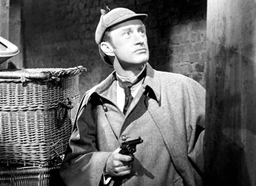 Sheldon Reynolds, an American producer, went to England looking for an actor to cast as Holmes in a new television series. Alan Wheatley had appeared in six televised plays (filmed live) for the BBC in 1951. Reynolds had much broader horizons. He found Ronald Howard, son of the famous English actor Leslie Howard. It was the senior Howard who insisted that Humphrey Bogart get to reprise his role of Duke Mantee when the successful play was turned into a film. It was Bogart’s first success on screen and helped launch his career. Howard was killed during World War II when the Nazis shot down his commercial plane over the Bay of Biscay.
Sheldon Reynolds, an American producer, went to England looking for an actor to cast as Holmes in a new television series. Alan Wheatley had appeared in six televised plays (filmed live) for the BBC in 1951. Reynolds had much broader horizons. He found Ronald Howard, son of the famous English actor Leslie Howard. It was the senior Howard who insisted that Humphrey Bogart get to reprise his role of Duke Mantee when the successful play was turned into a film. It was Bogart’s first success on screen and helped launch his career. Howard was killed during World War II when the Nazis shot down his commercial plane over the Bay of Biscay.
Ronald Howard sold his house and took his family to France in early 1954. The entire series was to be shot there to save on costs. Reynolds had used this approach before, filming the American series Foreign Intrigue, in Stockholm for reasons of economy. This time he would be an American producer, with a British Sherlock Holmes, shooting a television show in France.
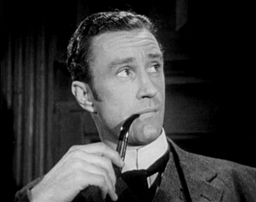 The series stood out from previous films and television episodes in that it was specifically designed to portray a younger Holmes and Watson. Holmes was about 27 when he met Watson at the beginning of their first adventure together, A Study in Scarlet. The brilliant Arthur Wontner had been 56 when he first played Holmes; the legendary Rathbone was 47. Jeremy Brett began his masterful portrayal at age 53. A youthful Holmes was simply not done.
The series stood out from previous films and television episodes in that it was specifically designed to portray a younger Holmes and Watson. Holmes was about 27 when he met Watson at the beginning of their first adventure together, A Study in Scarlet. The brilliant Arthur Wontner had been 56 when he first played Holmes; the legendary Rathbone was 47. Jeremy Brett began his masterful portrayal at age 53. A youthful Holmes was simply not done.
Howard was 35 and could sometimes pass for about ten years younger. This was not the Basil Rathbone image that had dominated movie screens in the forties. Howard summed up his approach by saying “In my interpretation, Holmes is not an infallible, eagle-eyed, out-of-the-ordinary personality, but an exceptionally sincere young man trying to get ahead in his profession.” Howard would play Holmes as an earnest, gifted young man with a sense of humor.
It’s Elementary – Basil Rathbone, still famous world-wide for his portrayal of the great detective, did not approve: “All I can say is, I think he’s too young for the role. I never thought of Holmes being so young.”
Howard Marion Crawford (referred to as H. Marion Crawford for the series, presumably to avoid confusion with Ronald Howard) was selected as Watson. Howard felt that Crawford was a good choice. Alan Barnes, author of Sherlock Holmes on Screen, said that his portrayal made “an ideal counterpoint for Ronald’s…Holmes.” However, David Stuart Davies, in Starring Sherlock Holmes, is less complementary and says that the role was played in the same “hail fellow, well met school of performance as Nigel Bruce.
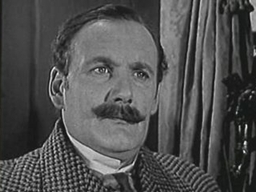 John H. Watson was about 29 years old when he first met Holmes. Crawford was 40 when the series was filmed, but looked a bit younger. Reynolds and Crawford faced a dilemma in how Watson should be presented. After the twelve Rathbone films made for Universal, Nigel Bruce had played Watson as a buffoon. This was the image that it seemed everyone had of the good doctor. The problem was that Doyle had painted a very different picture in the original stories.
John H. Watson was about 29 years old when he first met Holmes. Crawford was 40 when the series was filmed, but looked a bit younger. Reynolds and Crawford faced a dilemma in how Watson should be presented. After the twelve Rathbone films made for Universal, Nigel Bruce had played Watson as a buffoon. This was the image that it seemed everyone had of the good doctor. The problem was that Doyle had painted a very different picture in the original stories.
While Watson was nowhere near as brilliant as Holmes (who was?), he was a loyal, intelligent, dedicated companion on Holmes’ adventures. In fact, in the first two Rathbone films, The Hound of the Baskervilles and The Adventures of Sherlock Holmes, Bruce was a rather straightforward Watson and not comic relief. To change Bruce’s goofball performance could alienate the many fans that had liked the Rathbone-Bruce outings. However, Howard’s Holmes did not need a bumbling Watson. A reasonable middle ground was reached.
Crawford would often play a solid Watson, not afraid to use physical means to help Holmes, such as in The Cunningham Heritage. On the other hand, he would sometimes be not much of an accomplice in crime solving, as in The Case of the Belligerent Ghost. We were spoiled by the readily available performances by David Burke, and then Edward Hardwicke, in the Granada series. H. Marion Crawford does not receive the proper credit for helping evolve Watson’s on-screen portrayal from the Nigel Bruce films. Sadly, he died in 1969 from an overdose of sleeping pills.
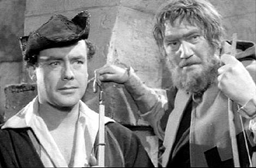 Archie Duncan was cast as Inspector Lestrade. Where Crawford did not portray the imbecile, Duncan did. As far as thinking went, Lestrade was just about as useless as Dennis Hooey’s portrayal had been in most of the Rathbone-Bruce films. He is less antagonistic towards Holmes than the character was in Doyle’s stories, but he just isn’t much of a policeman.
Archie Duncan was cast as Inspector Lestrade. Where Crawford did not portray the imbecile, Duncan did. As far as thinking went, Lestrade was just about as useless as Dennis Hooey’s portrayal had been in most of the Rathbone-Bruce films. He is less antagonistic towards Holmes than the character was in Doyle’s stories, but he just isn’t much of a policeman.
Duncan also played Malcolm MacGregan in The Haunted Gainsborough, where he wields quite the Scottish accent. He also played a Scotsman in The Graystone Inscription. It is immediately obvious who he is in each case. Several other case members would play multiple roles in different episodes as part of the cost savings measures. He’s best known for playing Little John opposite Richard Greene’s Robin Hood.
Each episode was filmed in about four days. Howard said that he had to get up early in the morning to learn his lines for the day’s shoot. There was a rushed feeling to the entire production. Howard’s self-assessment of the role was “I got no particular reactions out of it.”
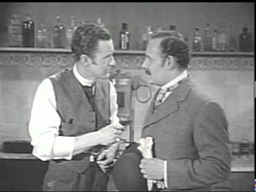 One feature of note was the Baker Street lodgings, designed by the same man who did the Exhibition of 1951 in London. It is quite possibly the best on-screen re-creation of 221B Baker Street yet seen. From the jackknife in the mantle to “VR” in carved out by pistol shots from Holmes, it captured the feel of Doyle’s descriptions.
One feature of note was the Baker Street lodgings, designed by the same man who did the Exhibition of 1951 in London. It is quite possibly the best on-screen re-creation of 221B Baker Street yet seen. From the jackknife in the mantle to “VR” in carved out by pistol shots from Holmes, it captured the feel of Doyle’s descriptions.
All of the shows began with The Case of, but I will dispense with that moniker in discussing the series. The very first episode, The Cunningham Heritage, depicted Watson and Holmes’ first meeting in the lab at St. Bart’s Hospital. Filmed for the first time, it is reasonably true to the scene as described in A Study in Scarlet.
Holmes breaks into a house to look for evidence, Watson punches out an armed villain, and Lestrade is in over his head. The character of the series was set in the first episode, and while it does compare favorably with the early Granada episodes, it was a serviceable pilot. We see the two men arranging their lodgings, with Holmes looking for his Stradivarius.
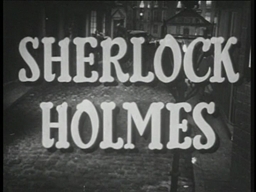 Reynolds, a canny producer, had considered that the pilot might not sell. So, he made sure that the next two episodes could fit together with the first. That would allow him to combine them into one film, which he could then distribute. But the pilot did sell and NBC televised it in America on October 18, 1954. It is interesting to note that the series did not show in England for several years, and I’m not certain if it ever aired at all in France.
Reynolds, a canny producer, had considered that the pilot might not sell. So, he made sure that the next two episodes could fit together with the first. That would allow him to combine them into one film, which he could then distribute. But the pilot did sell and NBC televised it in America on October 18, 1954. It is interesting to note that the series did not show in England for several years, and I’m not certain if it ever aired at all in France.
The second episode filmed and televised was Lady Beryl and it takes place only a few hours after The Cunningham Heritage case was solved. Peter Copley would play Lord Beryl. This was rather amusing, as the clean-shaven actor would don a moustache and appear as John Winthrop in the third episode filmed, The Winthrop Legend. It doesn’t take much to see the resemblance.
The Red Headed League was the only story directly adapted from the Canon, though several other shows would draw on the original stories to some degree. The Pennsylvania Gun is an almost exact adaptation of the first part of The Valley of Fear, eliminating the Scowrers flashback from the second part. The Christmas Pudding emulated The Empty House, including the use of a statue of Holmes.
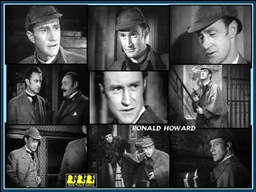 Lady Beryl contained elements of The Second Stain. There are similarities to the Five Orange Pips in The Winthrop Legend. The French Interpreter almost certainly was titled to create a link with The Greek Interpreter. And The Exhumed Client utilizes the theme from The Devil’s Foot.
Lady Beryl contained elements of The Second Stain. There are similarities to the Five Orange Pips in The Winthrop Legend. The French Interpreter almost certainly was titled to create a link with The Greek Interpreter. And The Exhumed Client utilizes the theme from The Devil’s Foot.
There were thirty-nine episodes in all and some discussion of another season, but that did not happen. It seems possible that if there had been more strong scripts, or a few more official tales licensed from the Doyle estate, more episodes would have followed. But it was a one-season series and Howard moved his family back to England; his brush with the great detective was over.
The entire series is usually available on DVD for under $10 and is well worth the price. Though some episodes are terrible (The Baker Street Nursemaids is unwatchable), many are good or better, and Howard’s humorous portrayal would be similar to Ian Richardson’s a few decades later.
It’s Elementary – It was this series that initiated the events that resulted in Reynolds’ future ex-wife, Andrea Plunkett, to claim that she owns the rights to the characters of Holmes and Watson and all the stories.
Along with Ian Richardson, I believe that Ronald Howard is one of the most under-appreciated Holmes’. He was saddled with several weak scripts and he inevitably was compared to Rathbone. But he absolutely brought a youth to the part and I really do think you can see Richardson’s own pawky sense of humor in Howard’s portrayal. It’s a series well worth watching.
Here’s another, longer post I wrote about Howard and the first two episodes of the series.
You can read Bob Byrne’s ‘The Public Life of Sherlock Holmes’ column here at Black Gate every Monday morning.
He founded www.SolarPons.com, the only website dedicated to the ‘Sherlock Holmes of Praed Street’ and blogs about Holmes and other mystery matters at Almost Holmes.
His “The Adventure of the Parson’s Son” is included in the largest collection of new Sherlock Holmes stories ever published.
I first heard of these shows when I was in college. Our local PBS station ran them during the middle of the night. I could never make myself stay up late enough to watch them.
Later, when I was married and in my twenties, a box set of twenty of the episodes came out, and I snapped it up, though I could ill afford it. I picked up the other episodes here and there on eBay. And then the complete series became available in numerous sets for sometimes $5 or less, and all my past sleuthing to find the episodes didn’t matter anymore.
In 1980, Sheldon Reynolds “remade” this show, with Geoffrey Whitehead and Donald Pickering as Holmes and Watson (respectively). Patrick Newell (Blessington from the 1985 Granada “The Resident Patient”) played Lestrade. This time, the series was filmed in Poland, and consisted of twenty-four episodes. Some are original to this series, and some are remakes of episodes from the 1954 Ronald Howard series, (“The Baker Street Nursemaids”, “Harry Crocker”, to name a few.) The pacing is very different with this show – lots of odd pauses and curious plinky music.
A little foraging will uncover some of these on YouTube. I’m not sure why they haven’t been released on DVD yet. Surely someone will realize there’s a little money to be made. I found all twenty-four of the episodes several years ago on eBay on six DVD’s. The quality isn’t great, but they’re watchable. I’d happily purchase cleaned up versions.
One other thing to mention: I went back to school for a second degree in the early 1990’s and early 2000’s. The university charged a number of fees that were useless to me as a returning adult student, but I did have free printing in the computer lab. That let me print off every traditional pastiche that I could find. (My wife is reference librarian, and she clued me in on some cool research techniques.) The reason I mention this is that, while digging around for pastiches, I came across several by a fellow named Bob Byrne. I printed them, of course, and it’s a good thing, since they’re gone now, as are many of the stories that roll onto the internet, only to vanish again.
One of these stories by this Mr. Byrne was “The Case of the Cursed Tower”, based on “The Exhumed Client”. I’m looking at it now, and it’s a shame that it’s gone from the net, as it’s quite good. (There’s even a little essay before the story that’s consistent with today’s blog post.) I’m going to suggest that Bob just go ahead and write up the other 38 Howard episodes, and the Geoffrey Whitehead stories as well, mostly just because I want to read them. Bob, if you knock out a few per day, it should only take a week or so. I’ll even finish up by saying “Please?”
Holmes Fan – my first encounter with Andrea Plunkett was because I was looking into obtaining permission to publish a book of pastiches based on episodes from this series. I think I even put together the outline for ‘The Christmas Pudding’ as the second story.
This series is one she actually DOES own the rights to!
You are going to see something from The Exhumed Client/Violent Suitor in a Pons pastiche…
Off-topic, but when are the stats for the July postings going to appear?
John posted that on Saturday.
https://www.blackgate.com/2015/08/15/the-top-50-black-gate-posts-in-july-3/
Bob,
Are you going to give a report on Pulpfest 2015? I’m assuming you went.
Whoops, sorry for overlooking the July postings ratings, Bob and John.
James – I was there for a chunk of Saturday, so I’m going to type up something on that. Fun event.
I’m not a Phillip Jose Farmer guy, but I think a Farmer fan would have had a good time talking with the FarmerCon guys that were there as well.
[…] I looked at one of my favorite, most under-appreciated Sherlock Holmes’, Ronald Howard with this post over at BlackGate.com. Howard gave us a younger, more humorous Holmes, laying the groundwork for […]
I first caught episodes from this series on late-night television. It was always jarring to go from Holmes to ads for 1-900 numbers but that was how they aired. Despite that, and despite already being a die-hard Brett fan, I enjoyed the series. I now have them on DVD and pull them out to rewatch from time to time. For all that they got wrong in the show, they got right the most essential thing to my mind – the friendship between Holmes and Watson. Crawford’s Watson is an excellent foil to Howard’s Holmes and it is a pleasure to watch them.
Thank you for the post! I stumbled into this series five years back and adore it—for all that it’s rushed production schedule can be felt in the tossed-together feel of the episodes, I completely agree with you that this Watson was a meaningful step forward towards more grounded Watsons, and that the young Holmes creates a unique and valuable approach to the character, whatever flack it may have earned him! It’s also one of the warmest Holmes and Watson relationships—you really do feel their friendship and genuine partnership.
Thanks again for writing, I really enjoyed reading this!